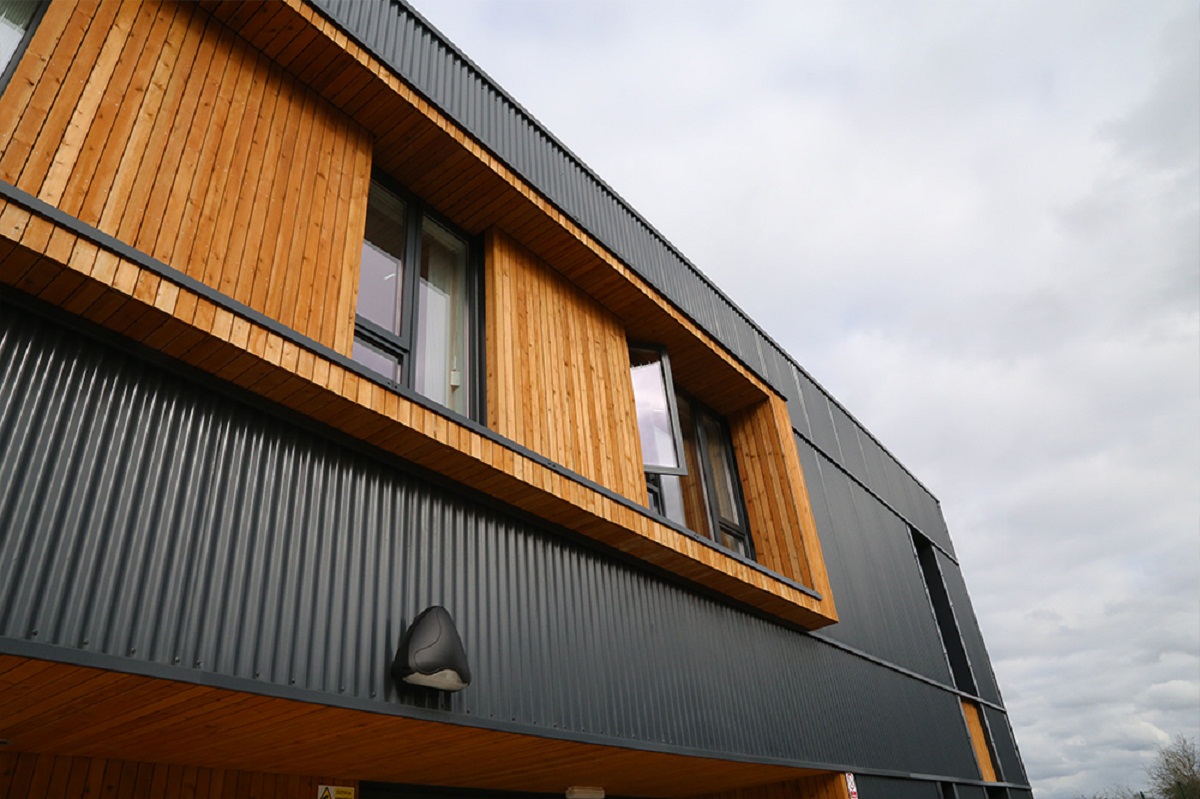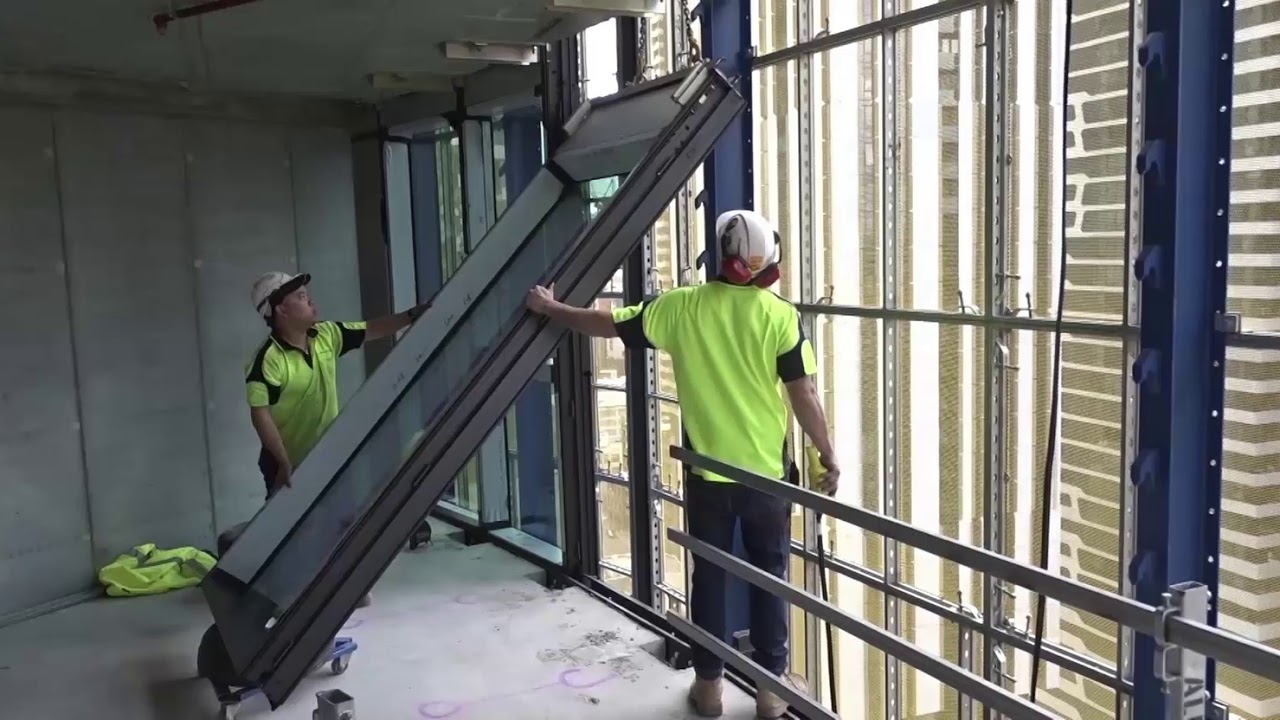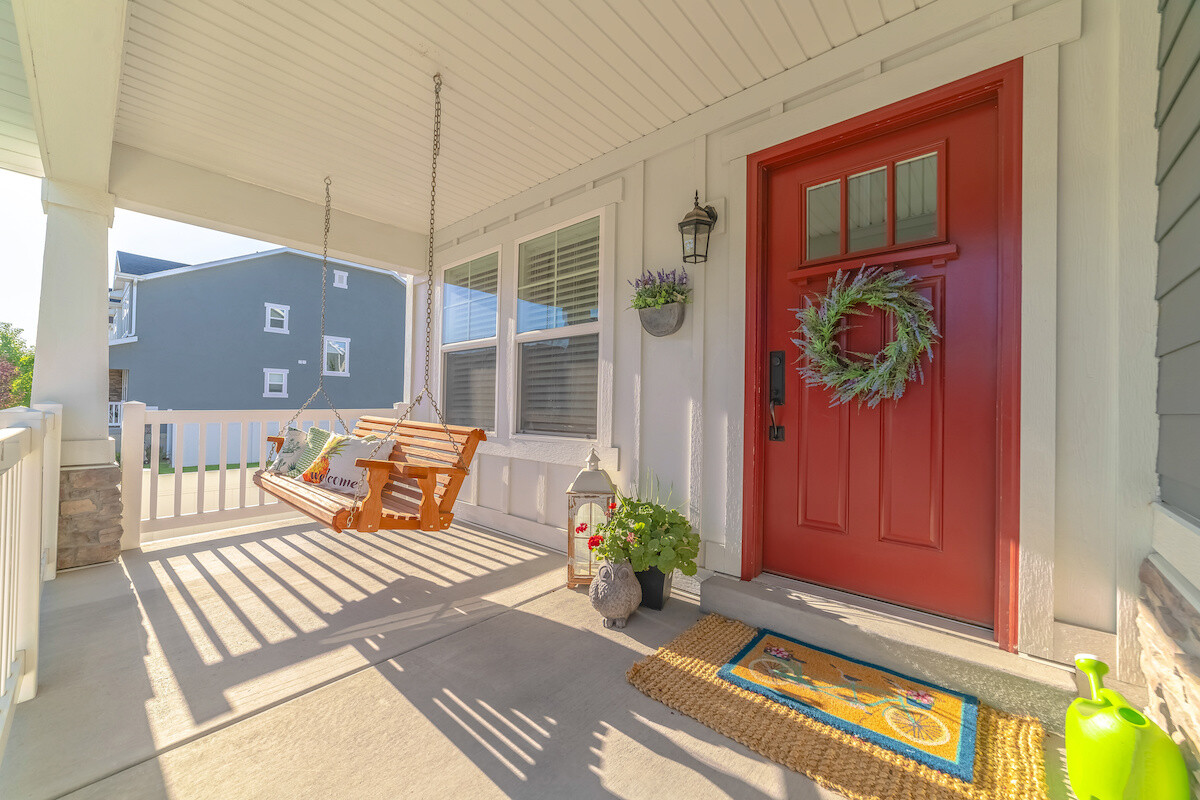Home>diy>Architecture & Design>What Does “Facade” Mean


Architecture & Design
What Does “Facade” Mean
Modified: December 7, 2023
Discover the meaning of "facade" in architecture design and how it contributes to the overall aesthetic and functionality of a building.
(Many of the links in this article redirect to a specific reviewed product. Your purchase of these products through affiliate links helps to generate commission for Storables.com, at no extra cost. Learn more)
Introduction
A facade is not just a simple architectural term, but a concept that holds deeper meanings in both physical and metaphorical realms. In architecture, a facade refers to the front exterior of a building, often carefully designed to create an impression and give a glimpse into what lies beyond. However, beyond its architectural significance, the concept of facade extends to various other aspects of our lives.
In this article, we will explore the multifaceted meaning of facade, delving into its historical context, architectural applications, figurative representations, and its significance in society, psychology, and personal relationships.
Throughout history, facades have played a crucial role in defining the visual identity of buildings. From ancient civilizations to modern skyscrapers, architects have used facades as a canvas to showcase their artistic vision and convey messages about the purpose, status, and character of a structure.
However, facades are not limited to physical structures; they can also be found in our everyday lives. In a figurative sense, a facade represents a mask that individuals use to project a certain image to the world. It is a shield that hides the true emotions, intentions, or vulnerabilities that lie beneath the surface.
Facades can be found in literature, where characters often conceal their true selves behind a carefully constructed persona. In films, the concept of a facade is often utilized to create suspense, reveal hidden truths, or explore the complexities of human nature.
Furthermore, facades play a significant role in society, where individuals and institutions may present themselves in a certain way to gain acceptance, power, or influence. Whether it is in politics, business, or social media, the facade can shape public perception and determine the success or failure of individuals or organizations.
Psychologically, facades can serve as defense mechanisms, allowing individuals to protect themselves from judgment, criticism, or emotional vulnerability. However, relying too heavily on a facade can hinder personal growth, hinder genuine connections, and lead to feelings of emptiness or disconnection.
As we explore the concept of facades in various contexts, it becomes evident that they are not just superficial or deceptive constructs. They are complex phenomena deeply embedded in human nature, architecture, literature, society, and psychology.
In this article, we will delve into the different dimensions of facades, uncovering their origins, exploring their significance, and reflecting on their impact on our lives. Whether we are admiring an architectural masterpiece or examining our own behavior, understanding the intricacies of facades can provide us with valuable insights into the human experience.
Key Takeaways:
- Facades are not just architectural fronts but metaphorical masks we wear, influencing personal relationships, societal dynamics, and the authenticity of human interactions.
- Understanding the multifaceted nature of facades empowers us to question motives, foster genuine connections, and navigate a world where authenticity is valued.
Read more: What Is A Facade?
Definition of Facade
At its core, a facade is the outward appearance or frontage of a building. It is the face that a structure presents to the world, and it often reflects the architectural style, design, and purpose of the building. The term “facade” originates from the French word “façade,” which means “frontage” or “face.”
In the realm of architecture, the facade serves as a visual representation of a building’s character. It can be simple and elegant, ornate and intricate, or sleek and modern, depending on the architectural style and the intentions of the architect. The facade often incorporates various elements, such as windows, doors, columns, decorative motifs, and materials like stone, brick, glass, or metal.
However, the concept of facade extends far beyond its architectural meaning. It carries a metaphorical weight that encompasses the idea of presenting a false front, hiding truths, or masking one’s true intentions or emotions.
Metaphorically, a facade refers to the superficial or deceptive aspects of something or someone. It represents a carefully constructed image designed to create a favorable impression, gain acceptance, or maintain a certain outward appearance. The facade acts as a shield, protecting the inner complexities, vulnerabilities, or inconsistencies from being exposed.
This figurative meaning of facade can be found in various contexts, such as personal relationships, social dynamics, or even societal structures. People may present a facade to project an image of confidence, success, or happiness, even when their internal reality might be vastly different.
In a societal context, institutions or organizations may put forward a facade to convey a specific image, reputation, or brand. This could involve strategic marketing, carefully crafted public relations campaigns, or projecting an idealized version of their values and practices.
Furthermore, the concept of facade is not limited to human interactions. It can also be explored in the realms of literature and film. In literature, characters often wear a facade to hide their true selves, deceive others, or navigate complex social dynamics. Similarly, in films, the presence of a facade can be used to create intrigue, heighten suspense, or reveal hidden truths.
Overall, the definition of facade encompasses both the physical and metaphorical aspects of presenting a front, whether in architecture, personal relationships, societal structures, literature, or film. Understanding the nuanced layers of facade allows us to explore the complexities of human nature, unveil hidden truths, and question the authenticity of our interactions and surroundings.
Historical Context
The concept of facades traces its roots back to ancient civilizations, where the exteriors of buildings were designed to convey cultural, societal, and religious messages. From the grandiose temples of ancient Egypt to the elaborate facades of Greek and Roman structures, the aesthetics of facades have always played a significant role in architectural history.
In ancient Egypt, the facades of temples were adorned with intricate carvings, symbolic hieroglyphs, and majestic statues of gods and pharaohs. These facades were not merely decorative; they were intended to showcase the power and divinity associated with the deities or rulers worshipped within.
Fast forward to ancient Greece and Rome, where the concept of the facade became an essential element of architectural expression. Greek temples, with their iconic colonnades, pediments, and friezes, emphasized balance, proportion, and harmony. The facades were meticulously designed to create a sense of awe, aligning with the ideals of Greek philosophy and religious beliefs.
In Roman architecture, the facades grew even more elaborate, incorporating elements such as arches, domes, and intricate ornamentation. The legendary Colosseum, with its grand facade and monumental arches, served as a testament to the might and grandeur of the Roman Empire.
The Renaissance period witnessed a resurgence of interest in classical architecture, and facades became a focal point once again. Renowned architects like Andrea Palladio in Italy and Inigo Jones in England emphasized the use of symmetrical facades influenced by ancient Greek and Roman design principles. These facades were often adorned with decorative elements, such as pilasters, cornices, and sculptural embellishments, to evoke a sense of elegance and harmony.
As architectural styles evolved throughout the centuries, facades continued to reflect the prevailing design trends and cultural values of their time. From the Gothic cathedrals with their intricate stone traceries to the sleek and minimalist facades of modernist buildings, the history of facades is a testament to the ever-evolving nature of architecture.
Beyond architecture, facades have also played a role in other historical contexts. In politics, leaders have often utilized facades to project an image of strength, stability, and legitimacy to maintain power and influence. Similarly, the world of theater and performance art has explored the concept of facade extensively, with actors donning masks and personas to embody fictional characters and create captivating narratives.
Understanding the historical context of facades allows us to appreciate the rich tapestry of architectural and societal development throughout the ages. It highlights the inherent human desire to craft external appearances that reflect our values, aspirations, and cultural identities.
Architectural Facades
Architectural facades serve as the public face of a building, representing its style, purpose, and identity. They are the canvas upon which architects express their artistic vision, creating a visual narrative for the structure. Architectural facades encompass a wide range of styles, materials, and design elements, each with its own unique characteristics and aesthetic appeal.
One prominent architectural style known for its distinctive facades is Gothic architecture. Characterized by pointed arches, ribbed vaults, and intricate stone tracery, Gothic facades create a sense of awe and verticality. Cathedrals such as Chartres Cathedral in France and Cologne Cathedral in Germany are renowned for their elaborate facades, adorned with sculpture and stained glass windows that depict religious narratives and symbols.
The Renaissance period brought forth a shift in architectural facades, moving away from the ornate Gothic style towards a more harmonious and balanced approach. Influenced by ancient Roman and Greek design principles, Renaissance facades focus on proportion and symmetry. Examples include the Palazzo Vecchio in Florence and the Palazzo Farnese in Rome, showcasing simple yet elegant facades adorned with pilasters, cornices, and other classical elements.
During the Baroque period, facades became more dramatic and exuberant, characterized by dynamic and curvilinear forms. Ornate decoration, sculptures, and intricate detailing were used to create a sense of movement and spectacle. The Palace of Versailles in France is a prime example, with its grand facade featuring balconies, columns, and sculptural embellishments showcasing the splendor and opulence of the time.
As architecture evolved into the modern era, facades began to embrace simplicity, clean lines, and technological advancements. Modernist facades, exemplified by structures like the Bauhaus School in Germany and the Seagram Building in New York City, focus on functionality and minimalism. The use of glass, steel, and concrete allows for large windows, open spaces, and a sense of transparency.
Contemporary architecture continues to push the boundaries of facade design. The use of innovative materials, sustainable technologies, and cutting-edge digital techniques has revolutionized the possibilities for creating striking and energy-efficient facades. The Guggenheim Museum Bilbao in Spain, with its undulating titanium facade, or the Burj Khalifa in Dubai, with its sleek glass exterior, are examples of contemporary facades that captivate and inspire.
Architectural facades not only contribute to the aesthetic appeal of a structure but also play a vital role in its functionality. They provide protection from the elements, control natural light, and facilitate energy efficiency. Modern facades incorporate features such as double-glazed windows, insulating materials, and shading devices to optimize energy consumption and create comfortable interior environments.
Architectural facades are a reflection of their time and place, combining artistic expression, technical innovation, and functionality. They shape the urban landscape, evoke emotions, and create a lasting impression on those who experience them. As architecture continues to evolve, the possibilities for designing captivating and sustainable facades are limited only by the imagination of architects and the advancements in technology.
Figurative Meaning
Beyond its architectural context, the concept of facade holds a figurative meaning that extends into various aspects of our lives. In this sense, a facade represents a mask or a front that individuals present to the world, often concealing their true emotions, intentions, or vulnerabilities.
Figuratively, a facade can be seen as a protective shield, allowing individuals to maintain control over how they are perceived by others. It can serve as a defense mechanism, shielding one’s insecurities, fears, or true selves from the scrutiny of others. By carefully constructing a facade, individuals create a buffer between themselves and the outside world, preserving a sense of safety and maintaining control over their public image.
In personal relationships, facades can be used as a means of self-protection, preventing others from seeing our vulnerabilities or weaknesses. We may wear a facade of strength, confidence, or happiness, even when we are struggling internally. This can lead to a disconnection between our authentic selves and the image we project, inhibiting genuine connections and understanding with others.
In social interactions, facades can be employed to gain acceptance, validation, or power. People may present a facade that aligns with societal expectations or conforms to specific norms to fit in or achieve their goals. This can be observed in various spheres of life, such as the workplace, social gatherings, or online platforms, where individuals often curate and project an idealized version of themselves to gain recognition or influence.
Societal structures and institutions also rely on facades to shape public perception and maintain their position of power. Political leaders, corporations, and organizations often project an image of transparency, righteousness, or moral superiority, hiding any flaws or ulterior motives behind a carefully constructed facade. This facade can sway public opinion and influence the decisions and actions of society at large.
Literature and film extensively explore the concept of a facade, with fictional characters using it as a tool for deceit, mystery, or personal survival. Masks, alter egos, and hidden identities are often employed to create suspense and intrigue, allowing characters to navigate complex social dynamics and conceal their true motivations.
Understanding the figurative meaning of facades prompts us to question the authenticity of our interactions and the motivations behind the masks we wear. While facades can serve as a means of self-preservation and societal adaptation, they can also hinder personal growth, hinder genuine connections, and lead to a sense of isolation or disconnection.
By recognizing the existence of facades, we can strive for greater authenticity and vulnerability, forging relationships based on trust, empathy, and understanding. It is through embracing our true selves and allowing others to do the same that we can build deeper connections and foster a more genuine and compassionate society.
A facade is the front exterior of a building, often decorative and facing the street. It can also refer to a false appearance or illusion.
Read more: What Is A Brick Facade
Examples of Facades in Literature and Film
The concept of facades is not limited to the realm of architecture or personal relationships; it also permeates through the narratives of literature and film. In these storytelling mediums, facades play a crucial role in creating intrigue, exploring complex character dynamics, and uncovering hidden truths. Here are some notable examples:
- The Great Gatsby by F. Scott Fitzgerald: This iconic novel explores the facades people construct to navigate the wealthy and glamorous world of the 1920s. Jay Gatsby presents a facade of wealth and success to win the affection of Daisy Buchanan, while Daisy herself hides her true desires and uses a facade of innocence to maintain her social standing.
- Fight Club directed by David Fincher: In this thought-provoking film, both the protagonist (referred to as the Narrator) and Tyler Durden wear facades. The Narrator projects an image of conformity and stability during the day, while Tyler represents a rebellious alter ego that challenges societal norms and constructs.
- The Picture of Dorian Gray by Oscar Wilde: In this classic novel, Dorian Gray presents a facade of youth and beauty to the world, hiding a darker reality. His portrait, hidden away from prying eyes, gradually reveals the true consequences of his immoral actions, contrasting with his outwardly charming facade.
- A Streetcar Named Desire by Tennessee Williams: Blanche DuBois, the central character, puts on a facade of refinement, sophistication, and innocence to cope with the fading grandeur of her life. However, throughout the play, her facade crumbles, revealing her deeply troubled emotional state.
- American Psycho by Bret Easton Ellis: The novel explores the twisted mind of Patrick Bateman, who outwardly portrays the facade of a successful Wall Street investment banker but hides his psychopathic tendencies beneath the surface.
- The Truman Show directed by Peter Weir: The film revolves around Truman Burbank, who unknowingly lives his entire life in a carefully constructed reality television show. The whole world around him is a facade, carefully managed and controlled for the entertainment of the viewers.
These examples demonstrate the power of facades in storytelling. They showcase the intricate complexities of human nature and the endless possibilities of exploring the contrast between an individual’s perceived identity and their true selves. Through the lens of literature and film, we can delve into the nuances of facades, questioning their implications and reflecting on our own roles as both observers and participants in the construct of facades.
The Significance of Facades in Society
Facades play a significant role in society, influencing how individuals and institutions are perceived and shaping the dynamics of power, acceptance, and influence. Understanding the significance of facades in society can provide valuable insights into the mechanisms that govern our interactions and the construction of our collective reality.
One significant aspect of facades in society is their role in establishing credibility and maintaining reputations. In the realms of business, politics, and public life, individuals and organizations often present a carefully crafted facade to project an image of trustworthiness, competence, or legitimacy. This facade can help sway public opinion, attract clientele, secure investments, or win elections.
Social media has amplified the significance of facades in society, with individuals creating curated online personas to project a specific image or lifestyle. People often present an idealized version of themselves, showcasing their achievements, experiences, and relationships, while downplaying or concealing their struggles or insecurities. The pressure to maintain a facade on social media can lead to feelings of inadequacy, comparison, and a distorted sense of reality.
Facades also play a pivotal role in the realm of celebrity culture. Celebrities often project a carefully crafted public persona to maintain popularity and ensure their fans’ loyalty. Their carefully orchestrated images can shield their personal lives, creating a distance between their public personas and their true selves.
In society, institutions and organizations rely on facades to establish credibility and maintain public trust. Corporations may present themselves as socially responsible, employing sustainable practices or supporting charitable causes, to enhance their reputation. Political leaders may use facades to align with public sentiment or project an image of integrity and competence.
At times, facades can be employed to manipulate public opinion or deceive the masses. Propaganda, misinformation, and disinformation are all examples of facades used to shape narratives, influence public perception, and retain control over power structures. Recognizing and critically analyzing these facades is crucial for maintaining a well-informed and democratic society.
Facades also have an impact on personal relationships and social dynamics. Individuals often put up facades to fit societal expectations or to gain acceptance from others. People may hide their true thoughts, feelings, or identities behind a facade, fearing judgment or rejection if they were to reveal their authentic selves.
However, the reliance on facades in society can hinder genuine connections and hinder empathetic understanding. Breaking down facades and embracing vulnerability can create space for honest communication and foster deeper and more meaningful relationships.
Reflecting on the significance of facades in society encourages us to question the authenticity of the images presented to us and the motives behind them. It prompts us to be critical thinkers, to look beyond the surface, and to strive for transparency, empathy, and genuine human connection in our interactions.
Facades in Psychology and Personal Relationships
Facades play a significant role in psychology and personal relationships, shaping the way individuals interact, communicate, and form connections with others. Understanding the dynamics of facades in these contexts can provide valuable insights into the complexities of human behavior, vulnerability, and the pursuit of authenticity.
In psychology, facades can be seen as defense mechanisms that individuals employ to protect themselves from emotional pain, judgment, or rejection. People may present a facade to project an image of strength, confidence, or happiness, even when they are struggling internally. These facades serve as a shield, hiding insecurities, fears, or vulnerabilities beneath the surface.
However, relying too heavily on facades can hinder personal growth and genuine connections. When individuals hide their true selves behind a facade, they may struggle to develop authentic relationships based on trust and mutual understanding. Facades can create barriers to genuine intimacy, as they prevent others from truly getting to know and connect with the real person beneath the mask.
Within personal relationships, facades can also manifest in various ways. Individuals may put up a facade to project a certain image or meet societal expectations, fearing that revealing their true thoughts, feelings, or identities may lead to rejection or criticism. This can create a disconnection between partners, friends, or family members, as the facade prevents true emotional vulnerability and intimacy.
Additionally, facades can emerge as a result of societal pressure or cultural norms surrounding relationships. People may feel compelled to present themselves as perfect or to conform to certain relationship ideals, even if it means sacrificing their authenticity and true desires. This can lead to a lack of fulfillment and a disconnect between the expectations set by society and the genuine needs and desires of individuals.
Breaking down facades and fostering authenticity in personal relationships is crucial for creating deep and meaningful connections. It requires vulnerability, trust, and open communication. By allowing ourselves and others to be truly seen and understood, we can cultivate relationships that are built on a foundation of authenticity, acceptance, and genuine emotional connection.
Within the field of psychology, the exploration of facades goes beyond personal relationships and delves into the realms of identity and self-perception. Individuals may develop false selves or personas in an attempt to cope with past traumas, societal expectations, or feelings of inadequacy. Therapy and self-reflection can provide avenues for recognizing and dismantling these facades, allowing individuals to embrace their authentic selves and lead more fulfilling lives.
Acknowledging and understanding the presence of facades in psychology and personal relationships is an important step in cultivating healthier dynamics. It encourages individuals to examine their own motivations, embrace vulnerability, and strive for authentic connections rooted in genuine understanding and acceptance.
Conclusion
The concept of facades encompasses both architectural design and the metaphorical masks we wear in various aspects of our lives. From the grand facades of historical structures to the intricate facades we construct in personal relationships, facades hold significant meaning and influence our perception of the world and ourselves.
Architectural facades not only enhance the visual appeal of buildings but also reflect the cultural, social, and artistic values of their time. They provide a glimpse into the purpose and character of the structures they adorn, acting as visual narratives that shape our experience of the built environment.
Metaphorically, facades represent the masks we wear to present a certain image to the world. They can serve as protective shields, hiding our vulnerabilities, fears, or true intentions behind carefully crafted personas. Facades play a role in personal relationships, where individuals may project a facade to fit in, gain acceptance, or shield their true selves from potential judgment or rejection.
In society, facades are employed by institutions, organizations, and individuals to shape public perception, maintain reputations, or exert influence. The presence of facades can perpetuate an often superficial and deceptive environment, where authenticity and genuine connections may be challenged.
However, recognizing the presence of facades equips us with the ability to question and analyze the motives, intentions, and authenticity behind the images presented to us. It encourages us to engage in critical thinking, empathy, and vulnerability, fostering deeper connections and a more genuine understanding of ourselves and others.
In conclusion, facades are not merely superficial or deceptive constructs. They are complex phenomena deeply embedded in architecture, literature, film, society, psychology, and personal relationships. Understanding the intricacies and significance of facades enriches our perception and interactions, allowing us to navigate a world where authenticity and genuine connection are valued.
By peering beyond the facades that surround us, we may uncover hidden truths, challenge societal norms, and build relationships rooted in trust, empathy, and acceptance. Embracing authenticity and breaking down the barriers of facades can lead us toward a more meaningful and fulfilling existence, both as individuals and as a society.
Frequently Asked Questions about What Does "Facade" Mean
Was this page helpful?
At Storables.com, we guarantee accurate and reliable information. Our content, validated by Expert Board Contributors, is crafted following stringent Editorial Policies. We're committed to providing you with well-researched, expert-backed insights for all your informational needs.















0 thoughts on “What Does “Facade” Mean”